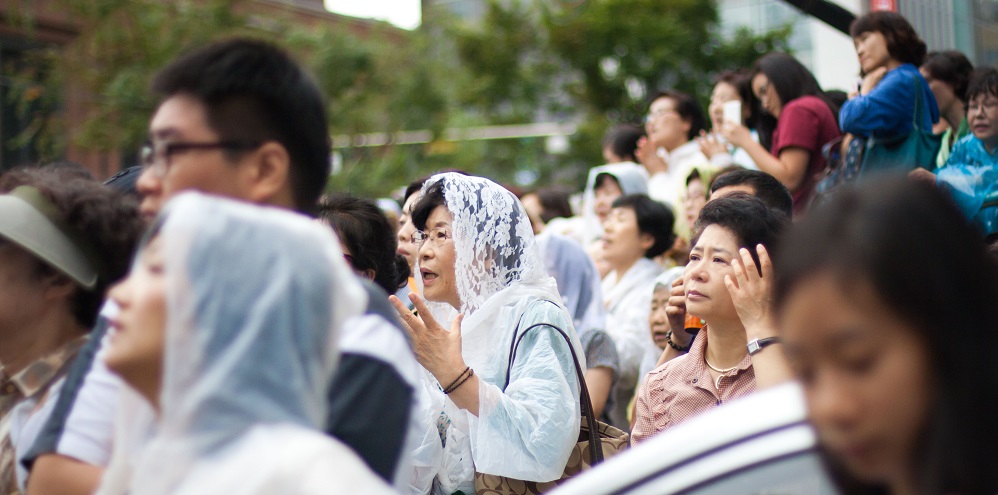The Peninsula
Native Korean Religions: The Old and the New

By Juni Kim
When gazing over the nighttime cityscapes of Seoul, one would be hard-pressed to miss the scores of red neon crosses that stretch across the city. Found on the tops of church steeples and multi-purpose buildings, this familiar sight exists in practically every metropolitan area in South Korea. Daytime strolls through the same neighborhoods may yield encounters with enthusiastic proselytizers preaching Christian, Buddhist, and other spiritual beliefs. Like other facets of traditional Korean culture that have melded with modern trends, South Korea’s religious environment is practically unique to itself. Unlike other regional neighbors such as Japan and China, South Korea houses a significant Christian population and no religious majority. According to the CIA Factbook, 32% of Koreans identify as Christians, 24% as Buddhists, and 43% as religiously unaffiliated. Korean culture is also steeped in native shamanistic traditions that pervade numerous facets of everyday life regardless of individual religious belief. Although hardly a new phenomenon, a number of native religious movements both large and small have attracted scores of devout Korean followers, intermingled with political causes, and in some cases have notoriously landed in news headlines.
Prior to modern times, Korean Confucianism, Buddhism, and indigenous shamanism were at different periods the dominant Korean theology. Religious syncretism often blurred the line between different beliefs and was common throughout Korean history. This remains true in the modern era. Koreans today may devoutly attend weekly Christian services while still performing ancestral worship rituals on holidays and even consult local shamans for fortunes. Korea’s syncretistic background is evident in native religious movements like Cheondoism, which incorporated both Confucian and Buddhist teachings. This native theology, which was started by Choe Je-u in the late 19th century, fed on social unrest and ultimately instigated the Donghak Rebellion in 1894 toward its peak in popularity. Fifteen of the thirty-three signers of South Korea’s Constitution in 1948 were Cheondoism adherents and it is represented politically in present-day North Korea, where a significant number of believers still exist.
The growing popularity of Christianity in South Korea throughout the 20th century has made it a common basis for modern native religious movements. One of the most prominent examples is the Unification Church, which was started by Reverend Sun Myung Moon in 1954 and is widely known for its mass wedding ceremonies. Although the true number of adherents are likely far less than the claimed three million followers, the Unification Church still retains a significant presence in South Korea and held a mass wedding of 3,800 couples earlier this year in Gapyeong. Ahn Sahng-hong, who founded the World Mission Society Church of God (WMSCOG) in 1964, also gained religious prominence in South Korea. He claimed to be the Second Coming of Jesus Christ and his church touts a membership of 1.7 million worldwide. Although not a separate religious dogma, another notable native religious movement is Minjung Theology, which emerged in South Korea in the 1970s and has been connected to former South Korean presidents Kim Young-sam and Kim Dae-jung. Minjung Theology framed Korean social injustice in a Christian context, which helped spread its popularity in the politically repressive South Korean governments of the 70s and 80s.
In addition to these major movements, South Korea also holds a noteworthy number of fringe religious groups. Although most of the groups are relatively obscure and have a small number of followers, some groups have appeared in headlines for infamous incidents. One such group was founded by Yoo Byung-eun, the de facto owner of the ferry company involved with the Sewol disaster, who was connected to a religious mass suicide incident in 1987.
Despite the spiritual nature of these native religious movements, there are examples of Korean nationalism that appear in the movements’ creeds. Based on the teachings of Ahn Sahng-hong, the World Mission Society Church of God claims that South Korea is a holy land and supports this belief with Biblical verses. Their English website states “although South Korea is a small nation at the ends of the east, it is a holy land, appointed as the place where God would come for a second time.” Sun Myung Moon similarly preached that Korea is the “Adam nation” in reference to Adam and Eve’s roles in the Biblical Garden of Eden. Tark Ji-il, a professor at Busan Presbyterian University, noted that the popularity of such religious groups in Korea is fueled in part by this ethnocentric doctrine. Tark was quoted in The Diplomat regarding Korean believers saying “Because they believe the new messiah is a Korean, the new revelation is written in Korean, the new nation who are going to be saved – 144,000 people – are Koreans, or the kingdom of God will be established in Korea (they can have many loyal Korea followers).”
Although nationalistic doctrine may appear to limit Korean religious movements to only Korean believers, movements like the Unification Church and the WMSCOG made significant proselyting efforts internationally. Reverend Moon, who passed away in 2012, moved to the Hudson River Valley to build his base of American followers and vigorously lobbied for influence in DC. The WMSCOG’s website states that the church has over 2,200 local congregations internationally and that over 1,000 members abroad visit their New Jerusalem Temple in Korea each year. Only time will tell if these groups will be able to sustain international followings, but their presence abroad shows their broadened appeal that extends past an exclusively Korean following.
Homegrown religious movements from Korea represent a combination of religious dogma and local traditions that are as unique as Korea itself. Although controversy and criticism often overshadows these groups, they are likely to continue and new religious movements will inevitably be established as well.
Juni Kim is an intern at the Korea Economic Institute of America. The views expressed here are the author’s alone.
Photo from Natasia Causse’s photostream on flickr Creative Commons.
